The Potential for Natural Stones from Northeastern Brazil to Be Used in Civil Construction
Abstract
1. Introduction
2. Materials and Methods
2.1. Materials
2.2. Characterization of Natural Stones
2.3. Physical-Mechanical Properties
2.4. Resistance to Chemical Attack
3. Results and Discussion
3.1. Chemical Composition, Mineralogical Phases, and Thermal Behavior of Natural Stones
3.2. Morphology and Microstructure of Natural Stones
3.3. Physical-Mechanical Properties
3.4. Resistance to Chemical Attack
4. Conclusions
Author Contributions
Funding
Data Availability Statement
Acknowledgments
Conflicts of Interest
References
- Pereira, D.; Marker, B. The Value of Original Natural Stone in the Context of Architectural Heritage. Geosciences 2016, 6, 13. [Google Scholar] [CrossRef]
- Pereira, D.; Cooper, B.J. Building stone as a part of a World Heritage Site:’Piedra Pajarilla’Granite and the city of Salamanca, Spain. Geol. Soc. Lond. Spec. Publ. 2014, 391, 7–16. [Google Scholar] [CrossRef]
- Bezerra, F.D. Rochas Ornamentais. Escritório Técnico Estud. Econômicos Nordeste ETENE 2018, 3, 1–22. [Google Scholar]
- Ericsson, M. XXIX World Marble and Stones Report 2018 by Carlo Montani. Miner. Econ. 2019, 32, 255–256. [Google Scholar] [CrossRef]
- Zulcão, R.; Calmon, J.L.; Rebello, T.A.; Vieira, D.R. Life cycle assessment of the ornamental stone processing waste use in cement-based building materials. Constr. Build. Mater. 2020, 257. [Google Scholar] [CrossRef]
- Figueirêdo, J.M.R.d.; Costa, F.P.d.; Fernandes, J.V.; Rodrigues, A.M.; Neves, G.d.A.; Menezes, R.R.; Santana, L.N.d.L. Development of Scheelite Tailings-Based Ceramic Formulations with the Potential to Manufacture Porcelain Tiles, Semi-Stoneware and Stoneware. Materials 2020, 13, 5122. [Google Scholar] [CrossRef] [PubMed]
- Fernandes, J.V.; Guedes, D.G.; Costa, F.P.d.; Rodrigues, A.M.; Neves, G.d.A.; Menezes, R.R.; Santana, L.N.d.L. Sustainable Ceramic Materials Manufactured from Ceramic Formulations Containing Quartzite and Scheelite Tailings. Sustainability 2020, 12, 9417. [Google Scholar] [CrossRef]
- Pereira, M.A.M.; Silveira, L.M.; Nannini, F.; Neves, L.P.; Perini, A.P.; Santos, C.J.; Belinato, W.; Santos, W.S. Dosimetric evaluation of individuals to 238 U series, 232 Th series and 40 K radionuclides present in Brazilian ornamental rocks using computational simulation. Ecotoxicol. Environ. Saf. 2019, 173, 401–410. [Google Scholar] [CrossRef] [PubMed]
- Abd El-Ghafour, N.G.; Khalil, M.H.; Gharib, M.E.; Abd Latif, M.L. Mineralogical and radioactive properties of some Egyptian granitoid rocks and their suitability for ornamental stones. HBRC J. 2012, 8, 64–68. [Google Scholar] [CrossRef]
- Montiel-Zafra, V.; Canadas-Quesada, F.; Campos-Suñol, M.J.; Vera-Candeas, P.; Ruiz-Reyes, N. Monitoring the internal quality of ornamental stone using impact-echo testing. Appl. Acoust. 2019, 155, 180–189. [Google Scholar] [CrossRef]
- Carvalhão, M.; Dionísio, A. Evaluation of mechanical soft-abrasive blasting and chemical cleaning methods on alkyd-paint graffiti made on calcareous stones. J. Cult. Herit. 2015, 16, 579–590. [Google Scholar] [CrossRef]
- Vázquez, P.; Luque, A.; Alonso, F.J.; Grossi, C.M. Surface changes on crystalline stones due to salt crystallisation. Environ. Earth Sci. 2013, 69, 1237–1248. [Google Scholar] [CrossRef]
- Benavente, D.; Martínez-Verdú, F.; Bernabé, A.; Viqueira, V.; Fort, R.; García Del Cura, M.A.; Illueca, C.; Ordóñez, S. Influence of Surface Roughness on Color Changes in Building Stones. Wiley Online Libr. 2003, 28, 343–351. [Google Scholar] [CrossRef]
- Gadioli, M.C.B.; Ponciano, V.M.; Rocha Bessa, B.d.H.; Camargo, J.L.; Pizeta, P.P. Characterization of ornamental stones wastes for use in ceramic materials. Mater. Sci. Forum 2019, 958 MSF, 129–134. [Google Scholar] [CrossRef]
- Khrissi, S.; Haddad, M.; Bejjit, L.; Lyazidi, S.A.; Amraoui, M.E.; Falguères, C. Preface: International Conference on Recent Trends in Physics (ICRTP 2016). IOP Conf. Ser. Mater. Sci. Eng. 2017, 186. [Google Scholar] [CrossRef]
- Elkarmoty, M.; Colla, C.; Gabrielli, E.; Bonduà, S.; Bruno, R. A Combination of GPR Survey and Laboratory Rock Tests for Evaluating an Ornamental Stone Deposit in a Quarry Bench. Procedia Eng. 2017, 191, 999–1007. [Google Scholar] [CrossRef]
- Abd, A.; Kahraman, E.A.S. Estimation of Durability Aspects of Al Masjid Al-Haram Marble, Makkah City, Saudi Arabia. Geotech. Geol. Eng. 2017, 35, 2763–2779. [Google Scholar] [CrossRef]
- Sassoni, E.; Graziani, G.; Franzon, E.; Scherer, G.W. Conversion of calcium sulfate dihydrate into calcium phosphates as a route for conservation of gypsum stuccoes and sulfated marble. Constr. Build. Mater. 2018, 170, 290–301. [Google Scholar] [CrossRef]
- Ruedrich, J.; Knell, C.; Enseleit, J.; Rieffel, Y.; Siegesmund, S. Stability assessment of marble statuaries of the Schlossbrücke (Berlin, Germany) based on rock strength measurements and ultrasonic wave velocities. Environ. Earth Sci. 2013, 69, 1451–1469. [Google Scholar] [CrossRef]
- Karaca, Z.; Hacımustafaoğlu, R.; Gökçe, M. Grain properties, grain-boundary interactions and their effects on the characteristics of marbles used as building stones. Constr. Build. Mater. 2015, 93, 166–171. [Google Scholar] [CrossRef]
- Vázquez, P.; Alonso, F.J.; Esbert, R.M.; Ordaz, J. Ornamental granites: Relationships between p-waves velocity, water capillary absorption and the crack network. Constr. Build. Mater. 2010, 24, 2536–2541. [Google Scholar] [CrossRef]
- Saba, M.; Hernandez-Romero, L.N.; Lizarazo-Marriaga, J.; Quiñones-Bolaños, E.E. Petrographic of limestone cultural heritage as the basis of a methodology to rock replacement and masonry assessment: Cartagena de indias case of study. Case Stud. Constr. Mater. 2019, 11. [Google Scholar] [CrossRef]
- Almada, B.S.; Melo, L.d.S.; Dutra, J.B.; Bubani, L.C.; Silva, G.J.B.; Santos, W.J.d.; Aguilar, M.T.P. Influence of the heterogeneity of waste from wet processing of ornamental stones on the performance of Portland cement composites. Constr. Build. Mater. 2020, 262, 120036. [Google Scholar] [CrossRef]
- Bacarji, E.; Toledo Filho, R.D.; Koenders, E.A.B.; Figueiredo, E.P.; Lopes, J.L.M.P. Sustainability perspective of marble and granite residues as concrete fillers. Constr. Build. Mater. 2013, 45, 1–10. [Google Scholar] [CrossRef]
- Souza, A.J.; Pinheiro, B.C.A.; Holanda, J.N.F. Processing of floor tiles bearing ornamental rock-cutting waste. J. Mater. Process. Technol. 2010, 210, 1898–1904. [Google Scholar] [CrossRef]
- Rodrigues, R.; De Brito, J.; Sardinha, M. Mechanical properties of structural concrete containing very fine aggregates from marble cutting sludge. Constr. Build. Mater. 2015, 77, 349–356. [Google Scholar] [CrossRef]
- Sousa, L.M.O.; Suárez del Río, L.M.; Calleja, L.; Ruiz de Argandoña, V.G.; Rodríguez Rey, A. Influence of microfractures and porosity on the physico-mechanical properties and weathering of ornamental granites. Eng. Geol. 2005, 77, 153–168. [Google Scholar] [CrossRef]
- Castro, N.F.; Mansur, K.L.; Frascá, M.H.B.d.O.; Silva, R.E.C. A heritage stone of Rio de Janeiro (Brazil): The Facoidal gneiss. Episodes J. Int. Geosci. 2021. [Google Scholar] [CrossRef]
- Castro, N.; Mansur, K.; Frascá, M.H. The augen gneiss of a bright and dark history. In Proceedings of the 21st EGU General Assembly, EGU2019, Vienna, Austria, 7–12 April 2019; 21, p. 1. [Google Scholar]
- Morales Demarco, M.; Oyhantçabal, P.; Stein, K.J.; Siegesmund, S. Granitic dimensional stones in Uruguay: Evaluation and assessment of potential resources. Environ. Earth Sci. 2013, 69, 1397–1438. [Google Scholar] [CrossRef]
- Pereira, D.; Blanco, J.A.; Peinado, M. Study on Serpentinites and the Consequence of the Misuse of Natural Stone in Buildings for Construction. J. Mater. Civ. Eng. 2013, 25, 1563–1567. [Google Scholar] [CrossRef]
- ASTM. ASTM C97/C97M—Standard Test Methods for Absorption and Bulk Specific Gravity of Dimension Stone; ASTM International: West Conshohocken, PA, USA, 2015. [Google Scholar]
- ASTM. ASTM C170/C170M—Standard Test Method for Compressive Strength of Dimension Stone; ASTM International: West Conshohocken, PA, USA, 2017. [Google Scholar]
- ASTM. ASTM C99/C99M—Standard Test Method for Modulus of Rupture of Dimension Stone; ASTM International: West Conshohocken, PA, USA, 2018. [Google Scholar]
- ASTM. ASTM C880/C880M—Standard Test Method for Flexural Strength of Dimension Stone; ASTM International: West Conshohocken, PA, USA, 2018. [Google Scholar]
- ASTM. ASTM C241/C241M—Standard Test Method for Abrasion Resistance of Stone Subjected to Foot Traffic; ASTM International: West Conshohocken, PA, USA, 2015. [Google Scholar]
- International Standards Organization. Ceramic Tiles: Determination of Chemical Resistance, ISO 10545-1—Part 13; International Standards Organization: Geneva, Switzerland, 2016. [Google Scholar]
- De Souza, F.; Bragança, S.R. Thermogravimetric analysis of limestones with different contents of MgO and microstructural characterization in oxy-combustion. Thermochim. Acta 2013, 561, 19–25. [Google Scholar] [CrossRef]
- Jakhar, S.R.; Mathur, R. Dimensional Stones: Weathering Nature and Technical Properties. Int. J. Sci. Res. 2015, 5, 710–715. [Google Scholar] [CrossRef]
- Urones, E.; Ramil, A.; Otero, C. Microstructural study of the origin of color in Rosa Porriño granite and laser cleaning effects. Appl. Phys. A 2011, 95–101. [Google Scholar] [CrossRef]
- Sajid, M.; Coggan, J.; Arif, M.; Andersen, J.; Rollinson, G. Petrographic features as an effective indicator for the variation in strength of granites. Eng. Geol. 2016, 202, 44–54. [Google Scholar] [CrossRef]
- Plevova, E.; Vaculikova, L.; Kozusnikova, A.; Ritz, M.; Simha Martynkova, G. Thermal expansion behaviour of granites. J. Therm. Anal. Calorim. 2016, 123, 1555–1561. [Google Scholar] [CrossRef]
- Yusof, N.Q.A.M.; Zabidi, H. Correlation of mineralogical and textural characteristics with engineering properties of granitic rock from Hulu Langat, Selangor. Procedia Chem. 2016, 19, 975–980. [Google Scholar] [CrossRef]
- Tuğrul, A.; Zarif, I.H. Correlation of mineralogical and textural characteristics with engineering properties of selected granitic rocks from Turkey. Eng. Geol. 1999, 51, 303–317. [Google Scholar] [CrossRef]
- Jeong, G.Y. The dependence of localized crystallization of halloysite and kaolinite on primary minerals in the weathering profile of granite. Clays Clay Miner. 2000, 48, 196–203. [Google Scholar] [CrossRef]
- Piller, W.E.; Egger, H.; Gross, M.; Harzhauser, M.; Hubmann, B.; Van Husen, D.; Krenmayr, H.-G.; Krystyn, L.; Lein, R.; Mandl, G.; et al. Die stratigraphische Tabelle von Österreich 2004 (sedimentäre Schichtfolgen). Osterr. Stratigr. Komm 2004, 9, 24–26. [Google Scholar]
- Baud, P.; Exner, U.; Lommatzsch, M.; Reuschlé, T.; Wong, T.-F. Mechanical behavior, failure mode, and transport properties in a porous carbonate. J. Geophys. Res. Solid Earth 2017, 122, 7363–7387. [Google Scholar] [CrossRef]
- Kourkoulis, S.K. Fracture and Failure of Natural Building Stones: Applications in the Restoration of Ancient Monuments; Springer Science & Business Media: Berlin, Germany, 2006; ISBN 978-1-4020-5076-3. [Google Scholar]
- Naeem, M.; BinSadiq, R.A.; Anwar, M.; Khalid, P. Mechanical properties and petrographic characteristics of Margala Hill limestone and Lockhart limestone of Rumli area, Islamabad Pakistan. Acta Geod. Geophys. 2014, 49, 441–454. [Google Scholar] [CrossRef]
- ASTM. ASTM C568/C568M—Standard Specification for Limestone Dimension Stone; ASTM International: West Conshohocken, PA, USA, 2015. [Google Scholar]
- Vigroux, M.; Eslami, J.; Beaucour, A.L.; Bourgès, A.; Noumowé, A. High temperature behaviour of various natural building stones. Constr. Build. Mater. 2021, 272, 121629. [Google Scholar] [CrossRef]
- Eslami, J.; Walbert, C.; Beaucour, A.L.; Bourges, A.; Noumowe, A. Influence of physical and mechanical properties on the durability of limestone subjected to freeze-thaw cycles. Constr. Build. Mater. 2018, 162, 420–429. [Google Scholar] [CrossRef]
- Buj, O.; López, P.L.; Gisbert, J. Caracterización del sistema poroso y de su influencia en el deterioro por cristalización de sales en calizas y dolomías explotadas en abanto (Zaragoza, España). Mater. Constr. 2010, 60, 99–114. [Google Scholar] [CrossRef]
- Karaca, Z.; Öztank, N.; Gökçe, M.V.; Elçi, H. Effects of surface-finishing forms and cement-filling on porous dimension limestone deterioration in cold regions. Cold Reg. Sci. Technol. 2011, 68, 124–129. [Google Scholar] [CrossRef]
- Pires, V.; Silva, Z.S.G.; Simão, J.A.R.; Galhano, C.; Amaral, P.M. “Bianco di Asiago” limestone pavement—Degradation and alteration study. Constr. Build. Mater. 2010, 24, 686–694. [Google Scholar] [CrossRef]
- Fronteau, G.; Moreau, C.; Thomachot-Schneider, C.; Barbin, V. Variability of some Lutetian building stones from the Paris Basin, from characterisation to conservation. Eng. Geol. 2010, 115, 158–166. [Google Scholar] [CrossRef]
- Török, Á. Surface strength and mineralogy of weathering crusts on limestone buildings in Budapest. Build. Environ. 2003, 38, 1185–1192. [Google Scholar] [CrossRef]
- Cardell, C.; Benavente, D.; Rodríguez-Gordillo, J. Weathering of limestone building material by mixed sulfate solutions. Characterization of stone microstructure, reaction products and decay forms. Mater. Charact. 2008, 59, 1371–1385. [Google Scholar] [CrossRef]
- Cnudde, V.; Cwirzen, A.; Masschaele, B.; Jacobs, P.J.S. Porosity and microstructure characterization of building stones and concretes. Eng. Geol. 2009, 103, 76–83. [Google Scholar] [CrossRef]
- ASTM. ASTM C615/C615M—Standard Specification for Granite Dimension Stone; ASTM International: West Conshohocken, PA, USA, 2018. [Google Scholar]
- Gunes Yilmaz, N.; Karaca, Z.; Goktan, R.M.; Akal, C. Relative brittleness characterization of some selected granitic building stones: Influence of mineral grain size. Constr. Build. Mater. 2009, 23, 370–375. [Google Scholar] [CrossRef]
- Rivas, T.; Alvarez, E.; Mosquera, M.J.; Alejano, L.; Taboada, J. Crystallization modifiers applied in granite desalination: The role of the stone pore structure. Constr. Build. Mater. 2010, 24, 766–776. [Google Scholar] [CrossRef]
- ISO. ISO 10545-3:1995 Ceramic Tiles—Part 3: Determination of Water Absorption, Apparent Porosity, Apparent Relative Density and Bulk Density; International Standards Organization: Geneva, Switzerland, 2014. [Google Scholar]
- Harvey, R.D.; Frye, J.C. Thermal Expansion of Certain Illinois Limestones and Dolomites; State of Illinois Department of Registration and Education, Illinois State Geological Survey: Urbana, IL, USA, 1967; Volume 415. [Google Scholar]
- Siegesmund, S.; Mosch, S.; Scheffzük, C.; Nikolayev, D.I. The bowing potential of granitic rocks: Rock fabrics, thermal properties and residual strain. Environ. Geol. 2008, 55, 1437–1448. [Google Scholar] [CrossRef]
- Weiss, T.; Siegesmund, S.; Kirchner, D.T.; Sippel, J. Insolation weathering and hygric dilatation: Two competitive factors in stone degradation. Environ. Geol. 2004, 46, 402–413. [Google Scholar] [CrossRef]
- de Castro Lima, J.J.; Paraguassú, A.B. Linear thermal expansion of granitic rocks: Influence of apparent porosity, grain size and quartz content. Bull. Eng. Geol. Environ. 2004, 63, 215–220. [Google Scholar] [CrossRef]
- Siegesmund, S.; Sousa, L.; Knell, C. Thermal expansion of granitoids. Environ. Earth Sci. 2018, 77, 41. [Google Scholar] [CrossRef]
- Costa, F.P.d.; Morais, C.R.d.S.; Rodrigues, A.M. Sustainable glass-ceramic foams manufactured from waste glass bottles and bentonite. Ceram. Int. 2020, 46, 17957–17961. [Google Scholar] [CrossRef]
- Costa, F.P.d.; Morais, C.R.d.S.; Pinto, H.C.; Rodrigues, A.M. Microstructure and physico-mechanical properties of Al2O3-doped sustainable glass-ceramic foams. Mater. Chem. Phys. 2020, 256, 123612. [Google Scholar] [CrossRef]
- Siegesmund, S.; Dürrast, H. Physical and mechanical properties of rocks. In Stone in Architecture: Properties, Durability; Springer: Berlin/Heidelberg, Germany, 2011; pp. 97–225. ISBN 9783642144745. [Google Scholar]
- NBR 15844. Rochas para Revestimento—Requisitos para granitos. Assoc. Bras. Normas Técnicas 2015, 1–2. [Google Scholar]
- Fernandes, J.V.; Rodrigues, A.M.; Menezes, R.R.; Neves, G.d.A. Adsorption of anionic dye on the acid-functionalized bentonite. Materials 2020, 13, 3600. [Google Scholar] [CrossRef]
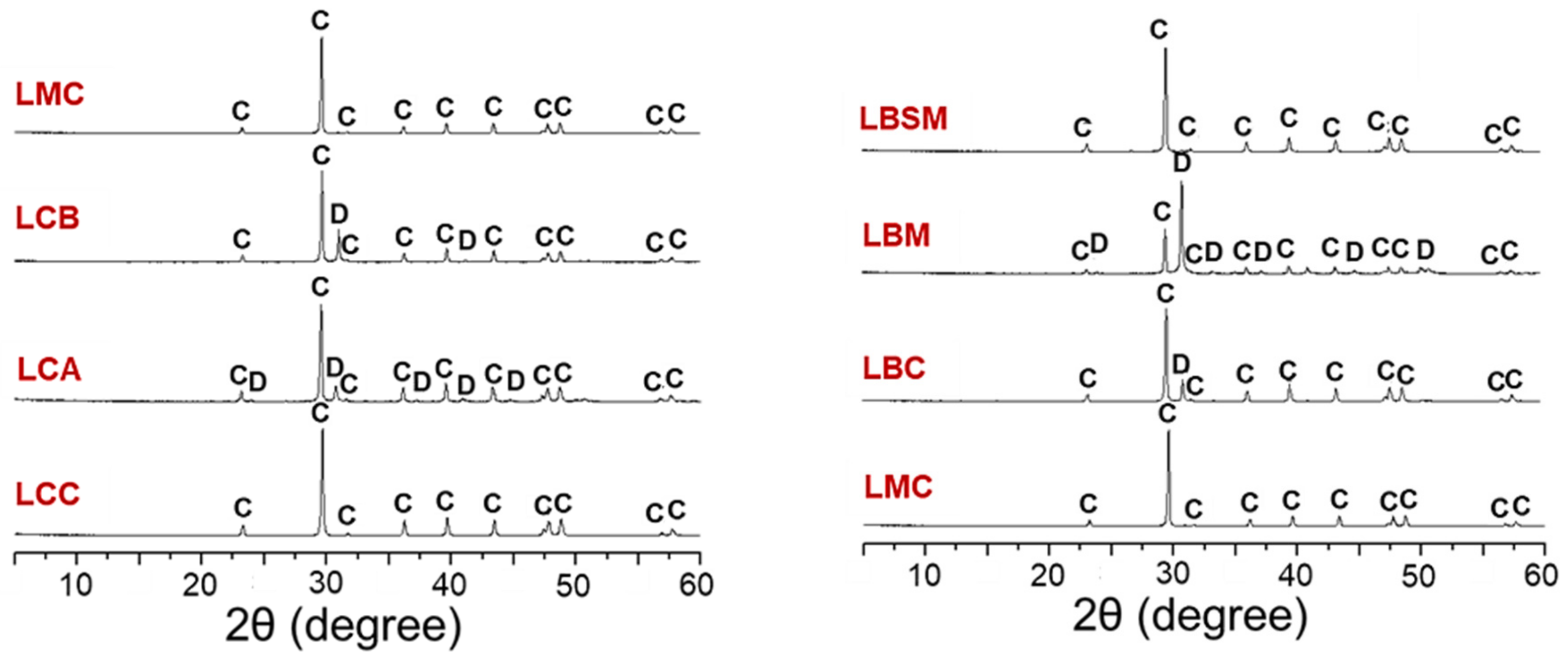
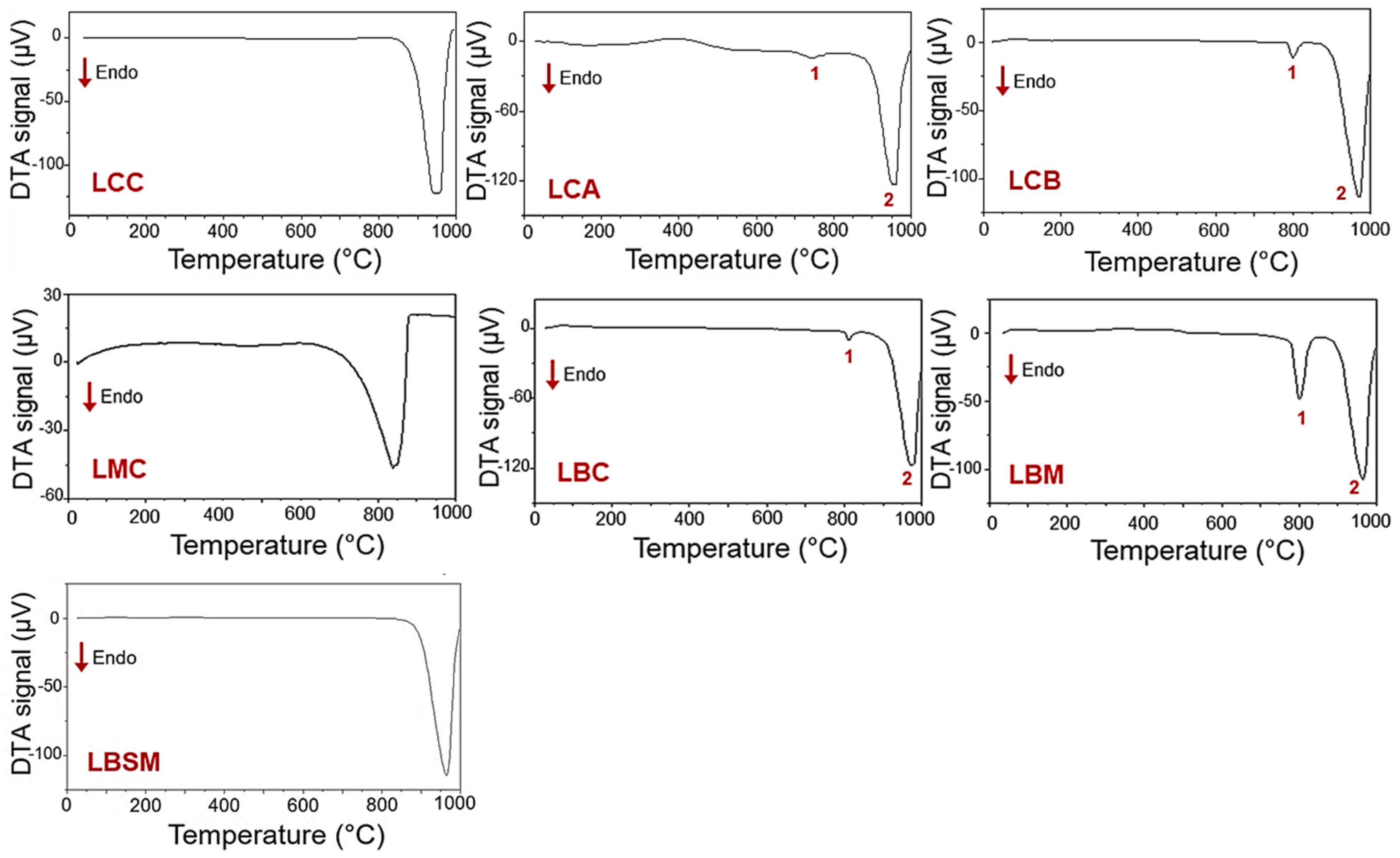

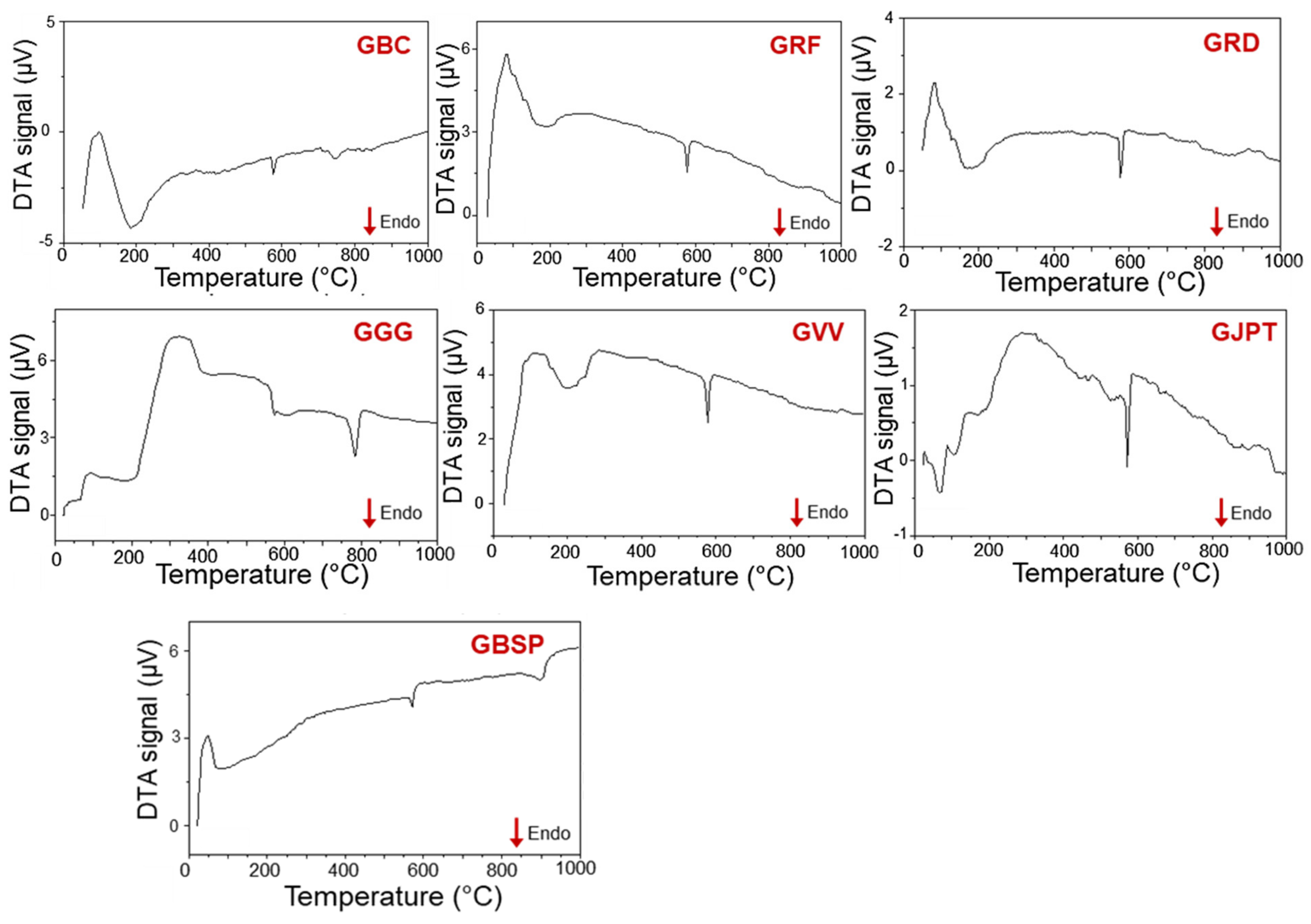





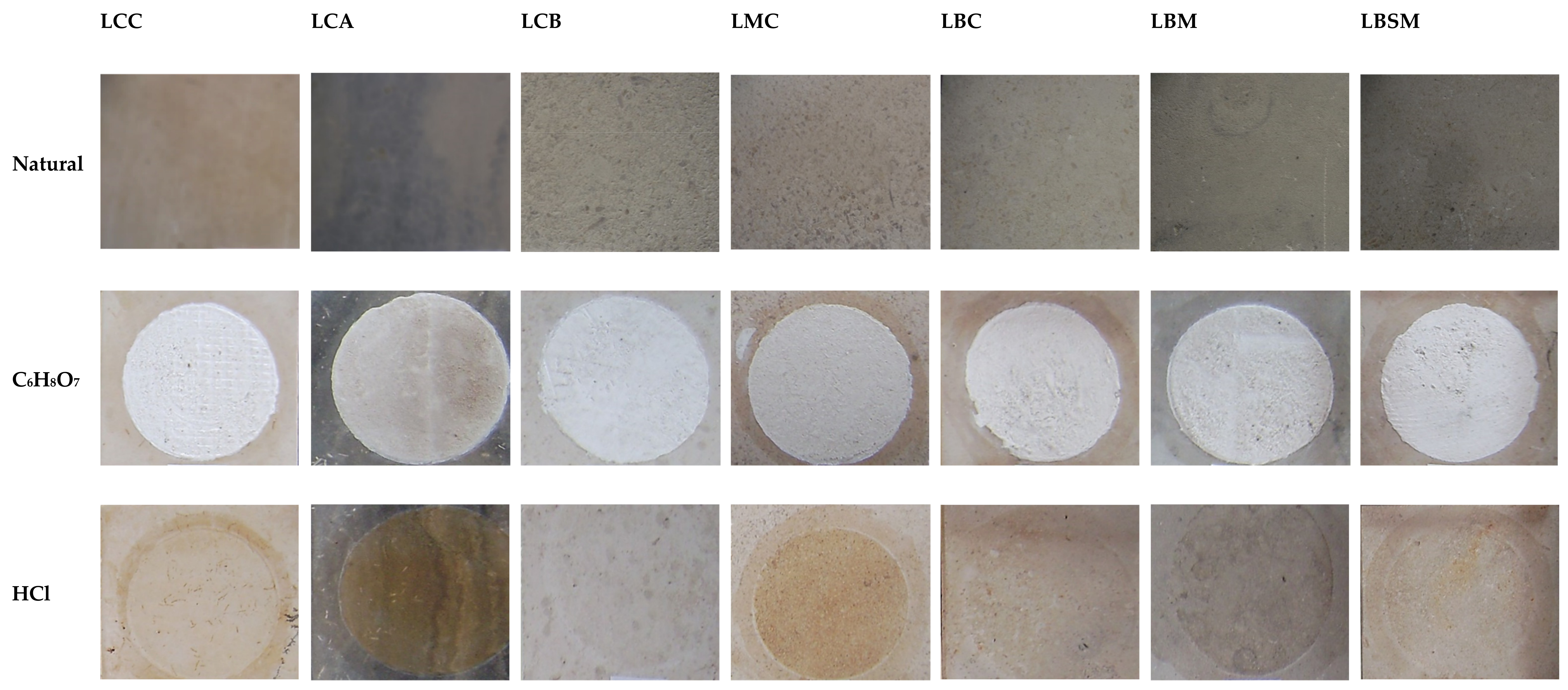
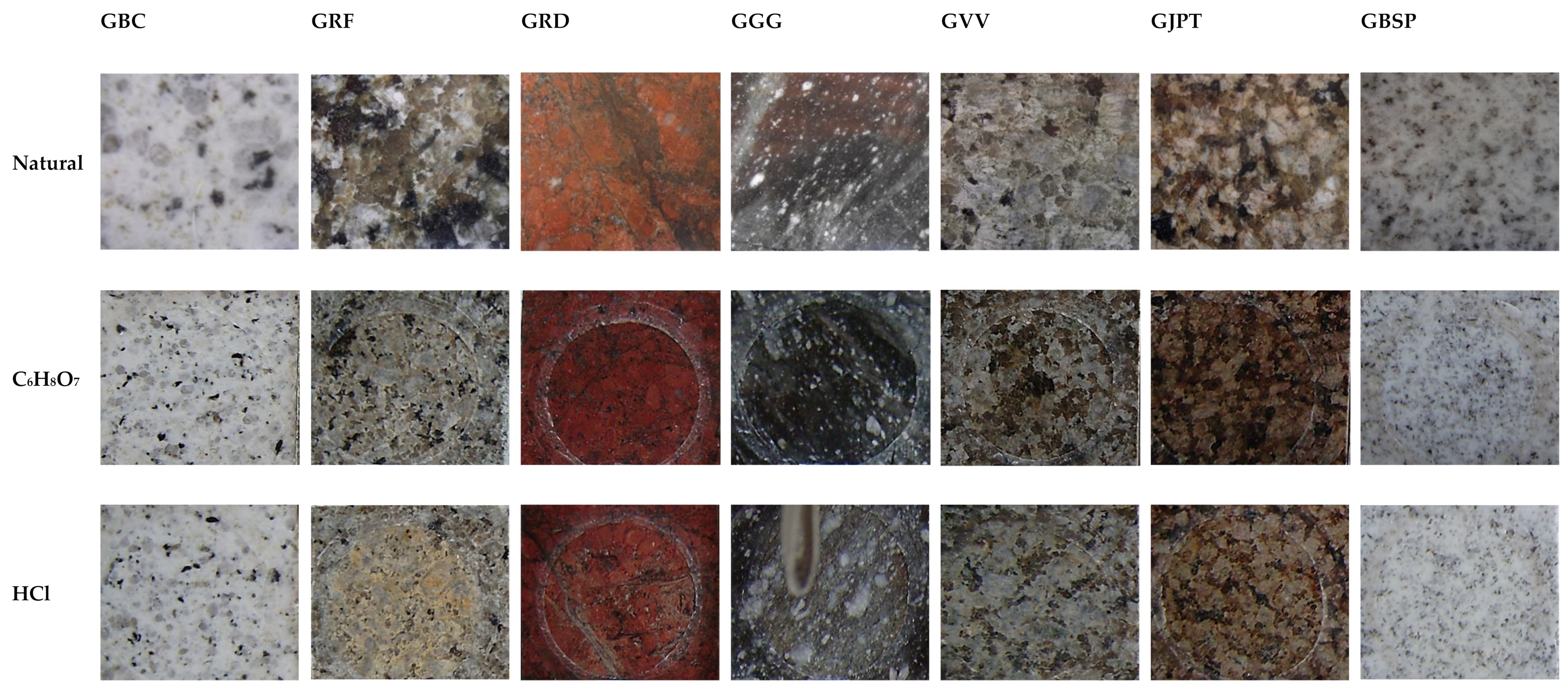

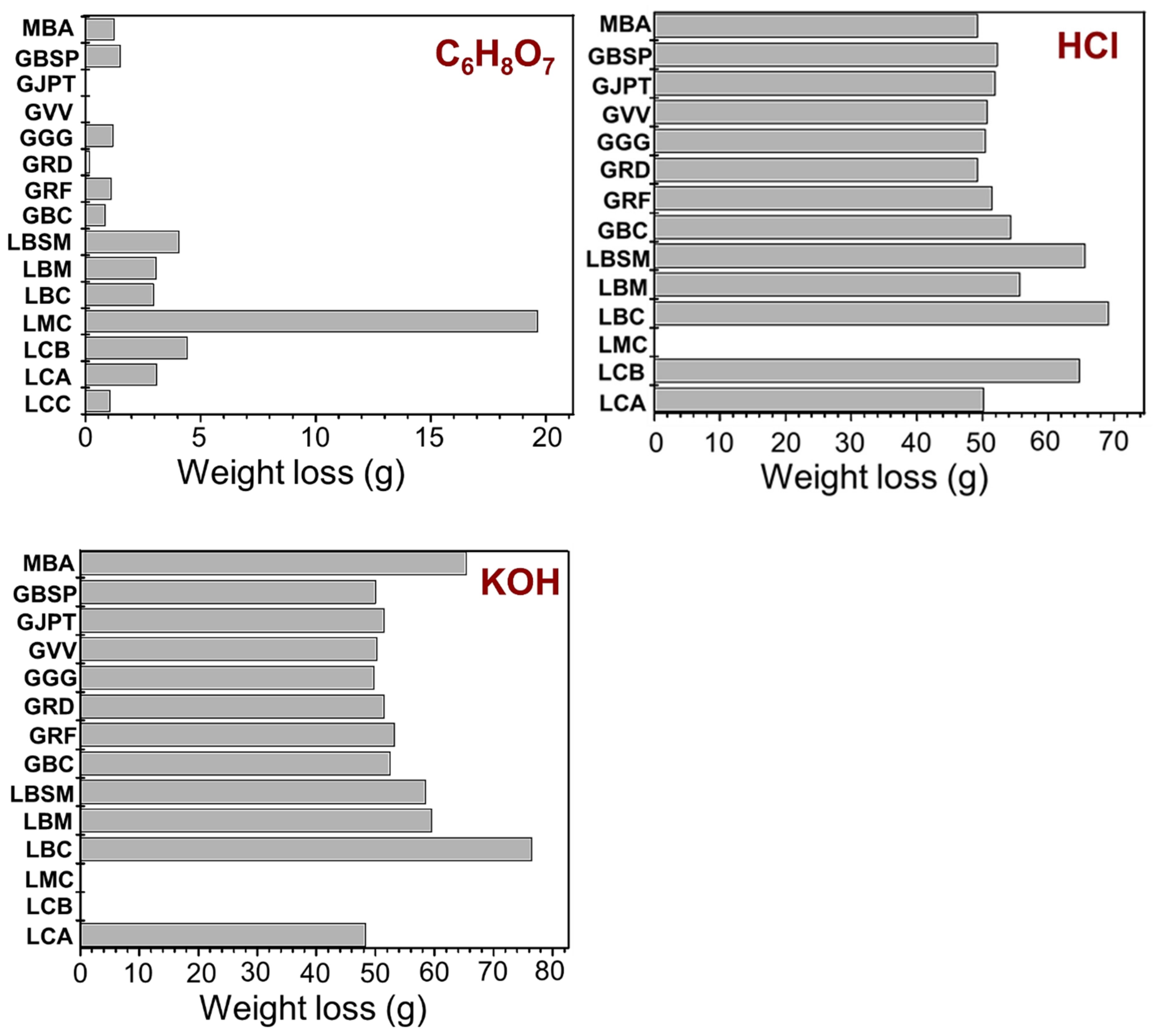
| Commercial Name | Nomenclature | Stone Types | City | Company |
|---|---|---|---|---|
| Pedra Cariri Creme | LCC | Limestone | Nova Olinda | Limestone Ceará |
| Pedra Cariri Azul | LCA | Limestone | Santana do Cariri | Limestone Ceará |
| Crema Buzius | LCB | Limestone | Limoeiro do Norte | Granus S/A |
| Mont Charmont | LMC | Limestone | Limoeiro do Norte | Granus S/A |
| Bege Capri | LBC | Limestone | Limoeiro do Norte | Mont Granitos S/A |
| Blue Marine | LBM | Limestone | Limoeiro do Norte | Mont Granitos S/A |
| Bege San Marino | LBSM | Limestone | Limoeiro do Norte | Mont Granitos S/A |
| Branco Ceará | GBC | Granite | Santa Quitéria | Granistone S/A |
| Rain Forest | GRF | Granite | Meruoca | Granus S/A |
| Red Dragon | GRD | Granite | Sobral | Imarf-Limestone e Granitos S/A |
| Green Galaxy | GGG | Granite | Marco | Imarf-Limestone e Granitos e S/A |
| Verde Ventura | GVV | Granite | Massapê | Multigran Ltd.a. |
| JuParaná Tropical | GJPT | Granite | Massapê | Multigran Ltd.a. |
| Branco São Paulo | GBSP | Granite | Santa Quitéria | Grandon S/A |
| Branco Acarapé | MBA | Marble | Acarape | Geolux |
| Reagent | Formula | pH | Concentration | Exposure Time |
|---|---|---|---|---|
| Ammonium chloride | NH4Cl | 5.0 | 100 g/L | 24 h |
| Sodium hypochlorite | NaClO | 8.0 | 20 mg/L | 24 h |
| Citric acid | C6H8O7 | 1.2 | 100 g/L | 24 h |
| Hydrochloric acid | HCl | 1.0 | 3% (v/v) | 96 h |
| Potassium hydroxide | KOH | 14.0 | 30 g/L | 96 h |
| Samples | Oxides (%mass) | |||||||||
|---|---|---|---|---|---|---|---|---|---|---|
| CaO | MgO | SiO2 | Al2O3 | K2O | Na2O | Fe2O3 | TiO2 | SO3 | Others | |
| LCC | 93.7 | 1.3 | 2.8 | 0.2 | 0.5 | 1.0 | 0.5 | |||
| LCA | 88.1 | 4.9 | 2.0 | 0.3 | 2.3 | 1.6 | 0.8 | |||
| LCB | 90.7 | 3.2 | 3.1 | 1.3 | 0.4 | 0.4 | 0.8 | 0.1 | ||
| LMC | 96.3 | 1.5 | 0.7 | 0.2 | 0.4 | 0.8 | 0.1 | |||
| LBC | 90.4 | 3.0 | 3.0 | 1.3 | 0.3 | 0.7 | 1.2 | 0.1 | ||
| LBM | 80.4 | 11.3 | 3.8 | 1.6 | 0.3 | 0.8 | 1.7 | 0.1 | ||
| LBSM | 95.9 | 1.7 | 0.2 | 0.8 | 1.2 | 0.2 | ||||
| Samples | Oxides (%mass) | |||||||||
|---|---|---|---|---|---|---|---|---|---|---|
| CaO | MgO | SiO2 | Al2O3 | K2O | Na2O | Fe2O3 | TiO2 | SO3 | Others | |
| GBC | 1.4 | 66.8 | 17.4 | 3.9 | 7.3 | 1.5 | 1.2 | 0.5 | ||
| GRF | 2.1 | 70.0 | 14.6 | 5.2 | 1.3 | 4.2 | 0.3 | 1.3 | 1.0 | |
| GRD | 0.8 | 66.7 | 16.0 | 7.2 | 1.0 | 5.9 | 0.6 | 1.1 | 0.7 | |
| GGG | 3.8 | 63.0 | 16.9 | 4.8 | 2.3 | 6.2 | 0.6 | 1.2 | 1.2 | |
| GVV | 1.4 | 69.3 | 14.4 | 5.5 | 3.0 | 2.7 | 0.2 | 2.3 | 1.2 | |
| GJPT | 1.7 | 67.5 | 14.4 | 5.6 | 5.1 | 3.9 | 0.4 | 1.0 | 0.4 | |
| GBSP | 1.0 | 70.2 | 18.3 | 4.8 | 2.7 | 0.5 | 1.3 | 1.2 | ||
| Samples | Oxides (%mass) | |||||||||
|---|---|---|---|---|---|---|---|---|---|---|
| CaO | MgO | SiO2 | Al2O3 | K2O | Na2O | Fe2O3 | TiO2 | SO3 | Others | |
| MBA | 61.4 | 28.2 | 7.3 | 0.7 | 0.2 | 0.8 | 1.1 | 0.3 | ||
| Samples | Physical Properties 1 | Thermal Expansion Coefficient 2 (10−6 °C−1) | Mechanical Properties | ||||||||
|---|---|---|---|---|---|---|---|---|---|---|---|
| Apparent Density (g/cm3) | Apparent Porosity (%) | Water Absorption (%) | Compressive Strength 1 (MPa) | Flexural Strength 1 (MPa) | Impact Resistance 1 (m) | Abrasion Wear Test (mm) | |||||
| Dry | Saturated | 30 °C to 50 °C | 40 °C to 100 °C | 500 | 1000 | ||||||
| LCC | 2.45 ± 0.01 | 2.50 ± 0.01 | 6.71 ± 0.59 | 2.75 ± 0.17 | 5.5 | 6.0 | 27.1 ± 2.3 | 14.9 ± 2.2 | 0.44 ± 0.08 | 2.56 | 5.06 |
| LCA | 2.52 ± 0.03 | 2.53 ± 0.01 | 1.88 ± 0.10 | 0.75 ± 0.06 | 6.0 | 7.0 | 30.2 ± 4.8 | 24.7 ± 2.3 | 0.55 ± 0.07 | 1.09 | 2.29 |
| LCB | 2.48 ± 0.02 | 2.53 ± 0.02 | 6.63 ± 0.44 | 2.72 ± 0.28 | 5.0 | 5.8 | 21.5 ± 6.0 | 13.2 ± 1.8 | 0.39 ± 0.06 | 2.85 | 5.59 |
| LMC | 2.25 ± 0.05 | 2.39 ± 0.05 | 13.74 ± 0.48 | 6.11 ± 0.21 | 5.1 | 6.2 | 16.5 ± 6.5 | 3.4 ± 0.2 | 0.42 ± 0.07 | 8.90 | 11.53 |
| LBC | 2.34 ± 0.03 | 2.45 ± 0.02 | 10.94 ± 1.48 | 4.73 ± 0.58 | 5.0 | 5.0 | 29.3 ± 4.6 | 6.0 ± 0.4 | 0.37 ± 0.06 | 5.78 | 8.85 |
| LBM | 2.41 ± 0.02 | 2.49 ± 0.01 | 8.19 ± 1.33 | 3.43 ± 0.56 | 6.0 | 5.3 | 34.3 ± 3.0 | 6.2 ± 0.6 | 0.40 ± 0.07 | 5.30 | 8.59 |
| LBSM | 2.37 ± 0.05 | 2.47 ± 0.04 | 10.12 ± 1.74 | 4.29 ± 0.86 | 4.5 | 5.1 | 34.1 ± 3.9 | 5.4 ± 0.6 | 0.37 ± 0.06 | 7.55 | 10.89 |
| GBC | 2.62 ± 0.01 | 2.62 ± 0.01 | 0.60 ± 0.02 | 0.23 ± 0.01 | 8.5 | 9.8 | 211.6 ± 21.2 | 17.6 ± 0.6 | 0.53 ± 0.06 | 0.25 | 0.51 |
| GRF | 2.62 ± 0.01 | 2.63 ± 0.01 | 0.43 ± 0.03 | 0.16 ± 0.02 | 7.7 | 9.0 | 96.4 ± 1.7 | 9.8 ± 1.2 | 0.60 ± 0.04 | 0.34 | 0.74 |
| GRD | 2.60 ± 0.01 | 2.61 ± 0.01 | 0.81 ± 0.05 | 0.31 ± 0.02 | 8.8 | 8.7 | 115.6 ± 9.6 | 13.5 ± 1.9 | 0.56 ± 0.04 | 0.34 | 0.77 |
| GGG | 2.69 ± 0.01 | 2.69 ± 0.01 | 0.35 ± 0.09 | 0.14 ± 0.05 | 9.0 | 8.8 | 122.6 ± 8.5 | 22.6 ± 4.1 | 0.55 ± 0.07 | 0.23 | 0.48 |
| GVV | 2.62 ± 0.01 | 2.62 ± 0.01 | 0.80 ± 0.05 | 0.29 ± 0.04 | 9.0 | 9.0 | 95.2 ± 9.8 | 11.5 ± 1.2 | 0.60 ± 0.03 | 0.51 | 0.75 |
| GJPT | 2.62 ± 0.01 | 2.62 ± 0.01 | 0.80 ± 0.05 | 0.29 ± 0.04 | 11.0 | 12.8 | 94.1 ± 13.3 | 13.6 ± 2.8 | 0.61 ± 0.04 | 0.43 | 0.88 |
| GBSP | 2.64 ± 0.01 | 2.65 ± 0.01 | 0.30 ± 0.04 | 0.10 ± 0.04 | 9.0 | 8.7 | 125.5 ± 10.9 | 21.1 ± 1.8 | 0.75 ± 0.03 | 0.11 | 0.43 |
| MBA | 2.86 ± 0.02 | 2.87 ± 0.02 | 0.31 ± 0.07 | 0.11 ± 0.05 | 6.0 | 8.8 | 91.6 ± 7.8 | 13.2 ± 4.8 | 0.72 ± 0.05 | 0.28 | 0.57 |
| Properties | Qualification of Natural Stone | ||||
|---|---|---|---|---|---|
| Low | Regular | Medium | Good | Great | |
| Water absorption (%) | (>3.0) LCB, LMC, LBC, LBM, LBSM | (1.0–3.0) LCC | (0.4–1.0) LCA | (0.1–0.4) All granites | (<0.1) |
| Apparent Porosity (%) | (>6.0) LCC, LCB, LMC, LBC, LBM, LBSM | (3.0–6.0) | (1.0–3.0) LCA | (0.5–1.0) GGG, GRF, GBSP | (<0.5) GBC, GRD, GVV, GJPT |
| Expansion Coefficient (mm × 10−3) | (>12) | (10–12) GJPT | (8–10) GBC, GRD, GGG, GVV, GBSP | (6–8) LCA, LBM, GRF, MBA | (<6) LCC, LCB, LMC, LBC, LBSM |
| Compressive Strength (MPa) | (<40) All limestones | (40–70) GRF | (70–130) GRD, GGG, GVV, GJPT, GBSP, MBA | (130–180) | (>180) GBC |
| Flexural Strength-3 Point (MPa) | (<6) LMC, LBC, LBSM | (6–12) LBM, GBC, GRF, GVV | (12–18) LCC, LCB, GRD, GJPT | (18–22) GBSP | (>22) LCA, GGG |
| Impact Strength (m) | (<0.30) | (0.30–0.50) LCC, LCB, LBM, LBC, LBM, LBSM | (0.50–0.70) LCA, GBC, GRF, GRD, GGG, GVV, GJPT | (0.70–0.95) GBSP, MBA | (>0.95) |
| Wear Resistance-Amsler (mm) | (>6.0) LMC, LBC, LBM, LBSM | (3.0–6.0) LCC | (1.5–3.0) LCA, LCB | (0.7–1.5) GRF, GRD, GVV, GJPT | (<0.7) GBC, GGG, GBSP, MBA |
| Samples | NH4Cl | NaClO | C6H8O7 | HCl | KOH | ||||||||||
|---|---|---|---|---|---|---|---|---|---|---|---|---|---|---|---|
| Brightness (GU) | Loss of Brightness (%) | Brightness (GU) | Loss of Brightness (%) | Brightness (GU) | Loss of Brightness (%) | Brightness (GU) | Loss of Brightness (%) | Brightness (GU) | Loss of Brightness (%) | ||||||
| I * | F * | I * | F * | I * | F * | I * | F * | I* | F * | ||||||
| LCC | 5 | 4 | 20.0 | 3 | 2 | 33.3 | 3 | 0 | 100 | 3 | 1 | 66.7 | 3 | 2 | 33.3 |
| LCA | 6 | 5 | 16.7 | 5 | 3 | 40.0 | 5 | 0 | 100 | 4 | 0 | 100 | 4 | 2 | 50 |
| LCB | 34 | 30 | 11.8 | 30 | 26 | 13.3 | 29 | 0 | 100 | 30 | 0 | 100 | 34 | 31 | 8.8 |
| LMC | 1 | 1 | 100 | 3 | 2 | 33.3 | 2 | 0 | 100 | 2 | 0 | 100 | 2 | 2 | 0 |
| LBC | 6 | 5 | 16.7 | 7 | 6 | 14.3 | 7 | 0 | 100 | 8 | 0 | 100 | 6 | 5 | 16.7 |
| LBM | 2 | 1 | 50 | 2 | 1 | 50 | 2 | 0 | 100 | 2 | 0 | 100 | 1 | 1 | 0 |
| LBSM | 1 | 1 | 100 | 1 | 1 | 100 | 1 | 0 | 100 | 1 | 0 | 100 | 1 | 1 | 0 |
| GBC | 80 | 75 | 6.3 | 78 | 73 | 6.4 | 78 | 74 | 5.1 | 74 | 69 | 6.8 | 76 | 73 | 3.9 |
| GRF | 82 | 67 | 18.3 | 80 | 77 | 3.8 | 80 | 65 | 18.8 | 79 | 65 | 17.7 | 78 | 76 | 2.6 |
| GRD | 79 | 64 | 19.0 | 76 | 71 | 6.6 | 78 | 73 | 6.4 | 78 | 73 | 6.4 | 74 | 70 | 5.4 |
| GGG | 77 | 64 | 3.9 | 78 | 76 | 2.6 | 74 | 58 | 21.6 | 75 | 56 | 25.3 | 67 | 63 | 6.0 |
| GVV | 81 | 76 | 6.2 | 83 | 79 | 4.8 | 63 | 40 | 36.5 | 77 | 48 | 37.7 | 77 | 72 | 6.5 |
| GJPT | 84 | 81 | 3.6 | 80 | 76 | 5.0 | 78 | 32 | 59.0 | 80 | 63 | 21.3 | 81 | 78 | 3.7 |
| GBSP | 78 | 70 | 10.3 | 76 | 73 | 3.9 | 74 | 69 | 6.8 | 70 | 67 | 4.3 | 77 | 74 | 3.9 |
| MBA | 52 | 38 | 26.9 | 60 | 58 | 3.3 | 56 | 0 | 100 | 55 | 0 | 100 | 47 | 43 | 8.5 |
Publisher’s Note: MDPI stays neutral with regard to jurisdictional claims in published maps and institutional affiliations. |
© 2021 by the authors. Licensee MDPI, Basel, Switzerland. This article is an open access article distributed under the terms and conditions of the Creative Commons Attribution (CC BY) license (https://creativecommons.org/licenses/by/4.0/).
Share and Cite
Costa, F.P.d.; Fernandes, J.V.; Melo, L.R.L.d.; Rodrigues, A.M.; Menezes, R.R.; Neves, G.d.A. The Potential for Natural Stones from Northeastern Brazil to Be Used in Civil Construction. Minerals 2021, 11, 440. https://doi.org/10.3390/min11050440
Costa FPd, Fernandes JV, Melo LRLd, Rodrigues AM, Menezes RR, Neves GdA. The Potential for Natural Stones from Northeastern Brazil to Be Used in Civil Construction. Minerals. 2021; 11(5):440. https://doi.org/10.3390/min11050440
Chicago/Turabian StyleCosta, Fabiana Pereira da, Jucielle Veras Fernandes, Luiz Ronaldo Lisboa de Melo, Alisson Mendes Rodrigues, Romualdo Rodrigues Menezes, and Gelmires de Araújo Neves. 2021. "The Potential for Natural Stones from Northeastern Brazil to Be Used in Civil Construction" Minerals 11, no. 5: 440. https://doi.org/10.3390/min11050440
APA StyleCosta, F. P. d., Fernandes, J. V., Melo, L. R. L. d., Rodrigues, A. M., Menezes, R. R., & Neves, G. d. A. (2021). The Potential for Natural Stones from Northeastern Brazil to Be Used in Civil Construction. Minerals, 11(5), 440. https://doi.org/10.3390/min11050440









